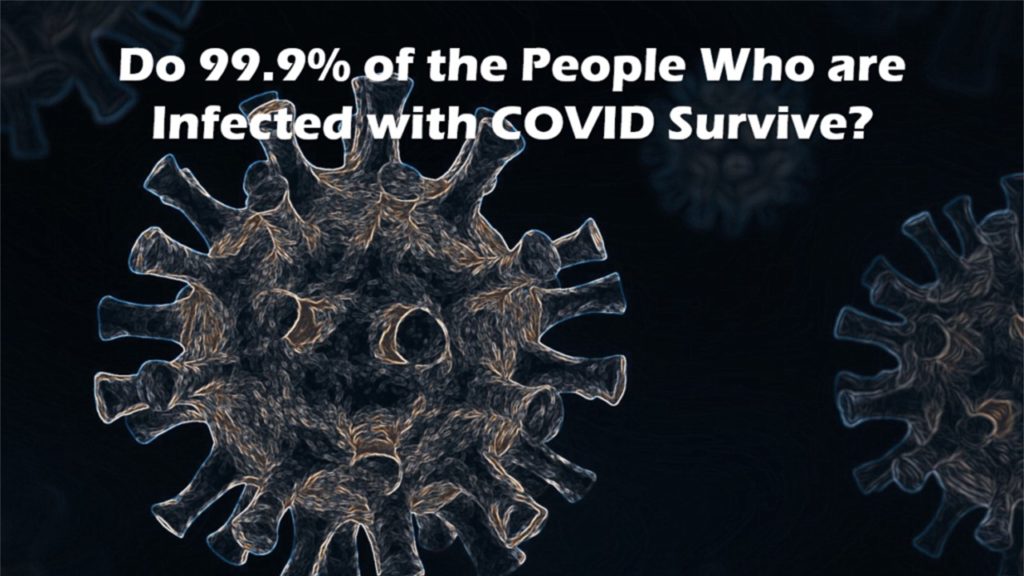The Crazy Quotes for COVID-19 Survival

The great news of the last 2 weeks is that COVID-19 cases are rapidly dropping now that we’re out of the mid-January annual peak for respiratory diseases. However, there’s still extremely misleading stuff being posted on social media. One of the single biggest myths I see are survival rates pulled from thin air. Let’s dive in.
The Problem
I’ll often see people just copy/paste random high COVID-19 survival numbers in social media posts. I know why they’re doing it, our crazy response to this pandemic has caused many small businesses to lose their shirts, which makes people hopping mad. They read on some website somewhere that 99% of people who get COVID-19 will survive, so they add the last decimal to that figure at random. So is this true?
Some Examples
These are comments from a recent Linkedin post of a news story about why about 1 in 4 Americans will likely never get vaccinated:
“For a virus that has a 99.98% survival rate…”
“…a 99.5% chance of survival…”
I’ve seen all sorts of other quotes, but the number posted is usually between these two.
The Problems with Measuring IFR
To figure out a survival rate, we need to know the actual IFR or Infection Fatality Rate for the virus. Meaning, how many people who get infected with the virus will perish. If you’ve read my blogs since March, I’ve been researching what’s been published on the IFR. It’s bounced from a high of 1 in 100 to a low of 1 in 2,000, which is pretty typical for a pandemic because much depends on where you’re measuring and how. For example, that number will be higher if you look for infected people coming into a hospital. It will be lower if you’re looking at people in the community who test positive for antibodies. However, each method has its problems.
On the hospital measurement side, you’re not finding people in the community who were infected and recovered and who never went to the hospital. That has the effect of increasing the IFR. On the community antibody side, you may not be accurately measuring the number of people who have antibodies which depends on where you measure. For example, if you go to the poorest parts of a city, you would find more people that were infected because of their jobs and close living conditions. If you go to the rich part of town, you’re going to find more people who could effectively quarantine and thus a lower positive antibody rate.
The Actual Data
In one recent study, they calculated the IFR by age which I then turned into survival rates. From the study: ” The estimated age-specific IFR is very low for children and younger adults (e.g., 0.002% at age 10 and 0.01% at age 25) but increases progressively to 0.4% at age 55, 1.4% at age 65, 4.6% at age 75, and 15% at age 85.”
Hence infection survival rates by age are:
- Age 55 =99.6%
- Age 65=98.6%
- Age 75=95.4%
- Age 85=85%
As you can see, none of the numbers from our posters above capture the risk based on these age groups. Your survival rate is better than 99.9% if you’re young and much lower as you age.
The authors conclude with this statement: “These results indicate that COVID-19 is hazardous not only for the elderly but also for middle-aged adults, for whom the infection fatality rate is two orders of magnitude greater than the annualized risk of a fatal automobile accident and far more dangerous than seasonal influenza.”
The main issue I see for the authors of the comments is that if they’re age 55 or under, all of this looks ridiculous to them. The chances of survival are so high that the idea of getting vaccinated isn’t tenable. However, none seem to understand how vaccines work. You often get vaccinated to protect others and help society at large.
Also, realize that it’s also likely that we’ve been keeping the IFR artificially low by all of the measures we’ve taken to avoid health system overload. Meaning had we just let this rip, that IFR would have been higher as hospitals became overwhelmed. As I have said since March, the only thing that makes any sense is to restrict people’s liberties when the hospitals are at risk of being overloaded.
The upshot? When you see these very high survival rates, these numbers tend to be accurate for younger people and inaccurate for middle-aged to older people. So if the poster is middle-aged or older, you now have an idea of what the real survival rate looks like.
_____________________________________
References:
(1) Levin AT, Hanage WP, Owusu-Boaitey N, Cochran KB, Walsh SP, Meyerowitz-Katz G. Assessing the age specificity of infection fatality rates for COVID-19: systematic review, meta-analysis, and public policy implications. Eur J Epidemiol. 2020 Dec;35(12):1123-1138. doi: 10.1007/s10654-020-00698-1. Epub 2020 Dec 8. PMID: 33289900; PMCID: PMC7721859.

NOTE: This blog post provides general information to help the reader better understand regenerative medicine, musculoskeletal health, and related subjects. All content provided in this blog, website, or any linked materials, including text, graphics, images, patient profiles, outcomes, and information, are not intended and should not be considered or used as a substitute for medical advice, diagnosis, or treatment. Please always consult with a professional and certified healthcare provider to discuss if a treatment is right for you.
